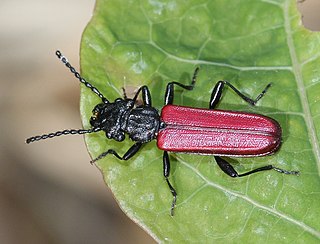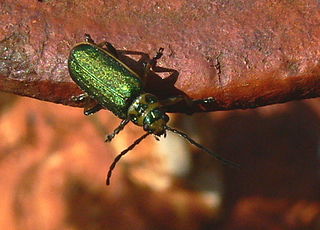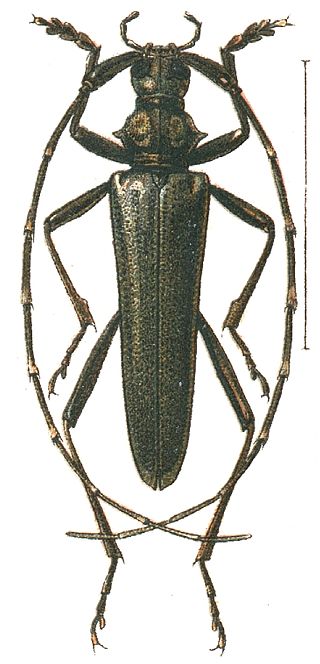
The longhorn beetles (Cerambycidae), also known as long-horned or longicorns, are a large family of beetles, with over 35,000 species described.

The bean weevils or seed beetles are a subfamily (Bruchinae) of beetles, now placed in the family Chrysomelidae, though they have historically been treated as a separate family. They are granivores, and typically infest various kinds of seeds or beans, living most of their lives inside a single seed. The subfamily includes about 1,650 species and are found worldwide.

The Cucujidae, or flat bark beetles, are a family of distinctively flat beetles found worldwide under the bark of dead trees. The family has received considerable taxonomic attention in recent years and now consists of 70 species distributed in five genera. It was indicated Cucujus species are scavengers, only feeding on pupae and larvae of other insects and on other subcortical beetles such as their own. Since the Cucujidae prey on larvae of potentially tree damaging beetles that spread fungal diseases, they are considered to be beneficial to the health of living trees.

The Galerucinae are a large subfamily of the leaf beetles (Chrysomelidae), containing about 15,000 species in more than 1000 genera, of which about 500 genera and about 8000 species make up the flea beetle tribe Alticini.

The Disteniidae are a small family of beetles in the superfamily Chrysomeloidea, traditionally treated as a group within the Cerambycidae.

Trechinae is a subfamily of ground beetles in the family Carabidae. There are 6 tribes, more than 430 genera, and over 6,700 described species in Trechinae.

Omma is a genus of beetles in the family Ommatidae. Omma is an example of a living fossil. The oldest species known, O. liassicum, lived during the final stage of the Triassic (Rhaetian), over 200 million years ago, though the placement of this species in Omma has been questioned. Numerous other fossil species are known from the Jurassic and Cretaceous of Europe and Asia. The only living species is Omma stanleyi, which is endemic to Australia. Three other extant species endemic to Australia that were formerly part of this genus were moved to the separate genus Beutelius in 2020.Omma stanleyi is strongly associated with wood, being found under Eucalyptus bark and exhibiting thanatosis when disturbed. Its larval stage and many other life details are unknown due to its rarity. Males are typically 14–20 mm in length, while females are 14.4-27.5 mm. Omma stanleyi occurs throughout eastern Australia from Victoria to Central Queensland.

Ross Taylor Bell was an American entomologist with particular interest in the invertebrate natural history of Vermont, United States, and carabid beetles. Together with his wife, Joyce Rockenbach Bell, his work at the University of Vermont was largely taxonomic, where they described more than 75% of the rhysodine species known to science. Ross also wrote a number of seminal papers in his chosen field.

Colaspis is a genus of leaf beetles in the subfamily Eumolpinae. It is one of the largest genera in the subfamily, containing over 200 species, and it is known from both North and South America. A number of species from this genus are considered to be pests, such as the grape colaspis. Some species are known from the fossil record from the Eocene of Colorado in the United States.

Geodorcus philpotti is a large flightless species of stag beetle in the family Lucanidae. It was named by Major Thomas Broun after Mr A. Philpott, who discovered it at Hump Ridge near Invercargill. It is endemic to New Zealand.
Myochrous is a genus of leaf beetles in the subfamily Eumolpinae. It is known from North, Central and South America. There are over 50 described species in Myochrous. The generic name is a combination of the Ancient Greek words μῦς (mouse) and χρῶμα (color).

Metachroma is a genus of leaf beetles in the subfamily Eumolpinae. It is distributed from Ontario, Canada to Mendoza, Argentina, including the Antilles. It has also been suggested that the genus extends to the Pacific Islands, though this is not confirmed. There are about 140 described species in Metachroma, 40 of which are found north of Mexico. An extinct species is also known from the Eocene of the United States.

Eumolpini is a tribe of leaf beetles in the subfamily Eumolpinae. It is the largest tribe in the subfamily, with approximately 170 genera found worldwide. Members of the tribe almost always have a longitudinal median groove on the pygidium, which possibly helps to keep the elytra locked at rest. They also generally have a subglabrous body, as well as appendiculate pretarsal claws.

Glyptoscelis is a genus of leaf beetles in the subfamily Eumolpinae. There are 38 species of Glyptoscelis described from North, Central and South America. There are also three species of Glyptoscelis known from the West Indies, though they are wrongly placed in the genus. In addition, a single species was described from Hunan, China in 2021.
Acrocyum is a genus of flea beetles in the family Chrysomelidae. There are six described species in Acrocyum, which are distributed in North and Central America, including the West Indies. The genus is included in the Blepharida-group of genera.
Xerolinus is a genus of darkling beetle. It consists of approximately thirty species found in the West Indies. Michael A. Ivie and Charles J. Hart named and circumscribed the genus in 2016.
Chalcosicya is a genus of leaf beetles in the subfamily Eumolpinae. It is mainly known from the West Indies, though one species is found in southern Mexico. It has recently been thought to be a sister genus to the Mediterranean Colaspidea, with Colaspina as a sister genus to the former two combined.

Metaxina is the only genus in the beetle family Metaxinidae. Its only species is Metaxina ornata. It endemic to the South island of New Zealand, where it is associated with sooty mold growing on Nothofagus trees. Both the larvae and adults are likely predaceous, feeding on insects and other arthropods. It is considered to be a member of the superfamily Cleroidea. Genetic studies have suggested that Metaxina should be considered a member of Chaetosomatidae, rather than constituting its own family.

Onthophagus luridipennis, is a species of dung beetle found in India, Sri Lanka, Thailand, and Indonesia.

Zecicindela is a genus of tiger beetles endemic to New Zealand. It is similar to Neocicindela, but can be separated by the shape of the labrum and the presence of hairs on the clypeus, frons, genae and pronotum.















